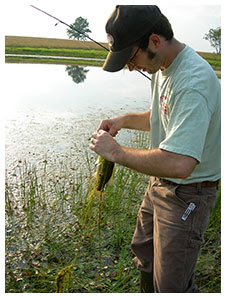Martin Luther King said "I have a dream..." and had a vision of change.
Lance Armstrong could see himself as a winner of a bicycle race. And not just one time; he could see winning again and again.
Steve Fossett wanted to go around the world in a balloon. And he did after several attempts.
A young man I know wants to go to Mars and is planning to study as a Doctor to get there. I won't be surprised when he arrives.

I imagined myself standing again on top of the Tooth of Time at Philmont Scout Ranch as I recovered from being treated for prostate cancer.
These people, and myself, put ideas and dreams into a vision, a picture of success, and then took action to get there.
The Next Generation of Conservation is a vision of success for a team. The team of the people of Missouri and the Missouri Department of Conservation. Take a look at the
Results we want to achieve in the document (
http://mdc.mo.gov/about/next_gen/) for the picture of success in Missouri for fish, forests, and wildlife.
When I look at the
Results we want to achieve items, that's where I see the vision, in the focus on results; the actions are simply some examples of the vision of success and some of the ways the vision will be achieved. The desired results can include many more pictures of success than are listed in the actions. I think it's important to focus on the desired results to see the picture of success.
In the opening letter, on page 1, is this sentence from the Director of the Missouri Department of Conservation:
"The coordinated efforts of all who care about Missouri's natural resources will be vital to ensuring our quality of life and healthy fish, forests, and wildlife for the future."

Anyone who lives in or visits Missouri is part of the conservation team and everyone can help and will benefit from the results.
I've worked with many teams in Missouri and in the United States. The people of Missouri and my colleagues in the Department of Conservation are some of the finest folks anywhere. We make a great team to tackle conservation issues. The people of Missouri have demonstrated their concern for conservation and their willingness to take action for decades.
In a 2003 survey where 6,352 Missourians responded, after being selected at random from all across Missouri, 93 percent indicated they were interested in Missouri's fish, forests, and wildlife; 56 percent said they were "Very interested."
In the same survey, 86 percent indicated they were familiar with the Missouri Department of Conservation. However, only 21 percent indicated they were "Very familiar" and a few, at 13 percent, said they were "Not at all familiar." Only a very few, 1 percent, said they "Don't know" when asked if they were familiar with the Department.
It is clear to me that Missourians
are interested in fish, forests, and wildlife in Missouri and yet there are still many opportunities to make all Missourians more aware of conservation efforts and how they do benefit from conservation success.
The Next Generation of Conservation from the Missouri Department of Conservation addresses my observations about the interests and awareness of Missourians in many of the
Results we want to achieve, for example:
more Missourians participating in fish-, forest-, and wildlife-related recreation;
hunting, fishing, and trapping valued as important recreational activities and population management tools;
and increased benefits of outdoor recreation to Missouri's economy, in the
Preserving Missouri's Outdoor Recreation Heritage goal category;
increased availability and use of conservation-related information;
Missourians understand present and future threats to fish, forest, and wildlife resources and participate in the protection of these resources;
and Missourians appreciate the natural world and the numerous benefits that derive from healthy fish, forest, and wildlife resources, in the
Teaching Missourians About Fish, Forest, and Wildlife Resources goal category;
private landowners and farmers actively managing their land for natural resource and financial sustainability, in the
Helping Private Landowners Advance Conservation category;
diverse and balanced recreation opportunities on public land that are consistent with resource management goals, in the
Serving Nature and You on Conservation Areas category;
and Missouri citizens providing frequent input into Conservation Department decisions and programs;
and fair and ethical business methods that enable Missourians to see how public funds are spent on conservation priorities, in the
Accounting for Department Operations category.
There are four other goals listed, with equally compelling desired results, and the immediate actions planned are also listed.

As a team, I'm sure achieving a shared picture of success is possible for conservation in Missouri, just like I made it to the top of the Tooth with a group, and the vision of success was achieved for Martin Luther King, Lance Armstrong, and Steve Fossett. I'm still waiting for the arrival on Mars of the young man I know.
You can read more about the nine goal categories, the
Results we want to achieve, and the
What we will do actions in
The Next Generation of Conservation available at:
http://www.mdc.mo.gov/conmag/2006/09/ and at:
http://mdc.mo.gov/about/next_gen/In case you are interested, the Tooth of Time is described at:
http://en.wikipedia.org/wiki/Tooth_of_Time and a satellite image is available at:
http://maps.google.com/maps?f=q&hl=en&q=cimarron,+nm&ie=UTF8&ll=36.445866,-104.999771&spn=0.071529,0.21698&t=h&om=1/A topographical view of the Tooth Ridge is available at:
http://www.topozone.com/map.asp?lon=-105.007&lat=36.4483
 A portal. When I was much younger I don't recall if portal was in our vocabulary.
A portal. When I was much younger I don't recall if portal was in our vocabulary.























